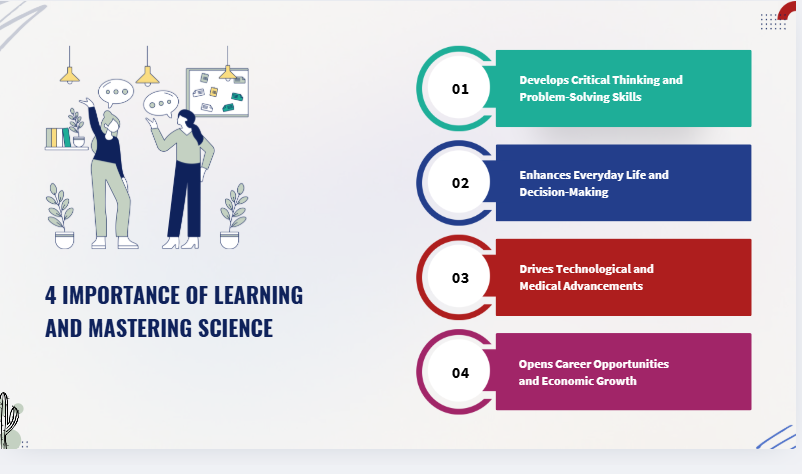GENERAL
Mastering High School Biology: How Online Tutors Can Help

We learn the workings of life on this planet and the function of cells and organisms through biology. Biology explains the world around us from cellular processes to whole ecosystems. Memorizing and applying countless facts makes high school biology challenging for many students.

Source: Canva
Finding a tutor is one way to simplify biology. However, online tutors offer customized assistance and walk the student through complex subjects easily and interestingly. You might have a hard time either memorizing the scientific terms or biology questions, so an online tutor can make your learning easier and more fun.
How Online Science Tutoring Removes The Complexity From Biology
Many students struggle to keep up with biology lessons in school. Large class sizes and fast-paced teaching can make it difficult to ask questions or request extra help. Enter online science tutoring, which can work wonders in a young student’s life. Students receive more hands-on attention with one-on-one tutoring and explanations in a way that resonates with their learning style.
Tutors explain hard-to-understand topics by dividing them into smaller, simpler steps, allowing you to grasp ideas of cellular division, DNA replication, and the circulatory system better.
Rather than pore over simple facts, students learn how various biological processes relate to one another in a way that’s easier to remember and apply. Tutors offer additional practice and real-world examples to help students understand the material more thoroughly.
Fostering Confidence in Biology
Students who find biology difficult often become frustrated and demotivated. If students struggle to grasp a concept in science, they might disengage from science entirely. A tutor builds confidence; by making the process of learning interactive and interesting, a tutor helps build confidence.
When students are given clear explanations and support in their learning, they report being more able to deal with difficulties in biology. Tutoring gives students the freedom to ask questions without shame, practice at their own pace, and review difficult concepts as often as necessary. As they learn more about biology, their confidence builds and they do better in class and on tests.
How One-on-One Tutoring is the Best
In a traditional classroom, teachers must spread their attention across many students. That means they can’t always devote extra time to ensuring one student grasps a challenging subject. Conversely, one-on-one tutoring is made to meet the student’s needs.
An online tutor can help to adjust the lessons according to the student’s strengths and weaknesses. For example, if a student has a hard time understanding genetics but enjoys studying ecosystems, the tutor can build on that interest to explain challenging concepts. This tailor-made approach improves the experience and effectiveness of learning.
Bringing Excitement Back to Biology
When it comes to biology, the prevailing notion among students is that it is purely about memorization of content and facts; however, this outlook encompasses only a fraction of the true nature of biology. A good tutor who is interactive and entertaining always uses charts, experiments, and examples from our everyday lives to make the learning process productive.
So, instead of simply reading a section on the digestive system, a tutor could illustrate how food moves through the body with animations. It can be easier to learn about photosynthesis when students recognize how it applies to the plants they see in their backyard. These creative techniques make biology much more fun and easier to recall.
These include quizzes, for example, along with discussion-based learning and games, all of which online tutors can use to keep students engaged. When students like what they are learning, motivation is high and retention is greater.
Tutoring for Help with Preparing for Exams
Biology tests often require students both to memorize many details and to apply what they learned. It is hard to study individually when there is a vast amount of information. A tutor helps the students to keep a check on their study plan and focus on the important concepts.
Tutors offer practice questions, clarify tricky topics, and impart test-taking strategies. They also teach students to organize their notes, compile flashcards, and review previous tests to identify weak spots. Students are confident and do well on their tests with the right preparation.
How Personalized Learning Improves Grades
A lot of students also have difficulty with biology simply because they don’t know how to study. It’s not always enough to just read a textbook. A tutor guides students’ discovery of learning methods that best work for them.
Some students grasp concepts better when watching videos, while others benefit from hands-on activities. Tutors identify these learning styles and tailor lessons accordingly. This allows students to learn the information better, which not only improves their grades but also gives them a better understanding of biology.
Common Biology Challenges And How To Tackle Them
Biology is a subject where some things are much easier to understand than others. Complicated processes like cell division, evolution, and the nervous system are difficult for students. All the following topics have many steps and are therefore not easy to follow.
Tutors can help break these topics into smaller portions and find ways to clarify them. Rather than rote learning, which often means trying to memorize everything all at once, students learn to logically understand each step of every process. This makes learning biology easier and more memorable.
Scientific terminology is another common challenge. The difficult terminologies present in biology can bamboozle students. A tutor uses mnemonic devices and practice examples to assist students in remembering these terms. In this way, learning becomes much more natural and less stressful.

Source: Canva
Ways in Which Parents Can Support Biology Learning
Supporting curiosity and creating a positive learning environment at home goes a long way. Even simple things like watching nature documentaries, discussing science wonders, or visiting a science museum can help make biology more fun.
If a student struggles with the subject, parents can find an online tutor who offers the additional help required. With the right encouragement and support, any student can become a biology whiz.
Conclusion
Biology is an incredibly interesting subject but can be difficult without proper support. In online science tutoring, the moderator guides students through complex topics, making it easy for them to learn and enabling them with better ways of understanding, building confidence, and achieving better grades.
A good tutor can help students create solid study habits, be prepared for tests, and develop a love for science. No matter if a student is falling behind or simply looking to get ahead, online tutoring provides valuable guidance for success.
FAQs
Can online tutoring help with bio-lab work?
Yes, online tutors can demonstrate lab protocols, guide students as they interpret results, and provide virtual experiments that enhance understanding.
What if I have difficulty memorizing scientific terms?
Tutors work with students on memory techniques like mnemonics and visualization to better recall biology terms.
Is online tutoring beneficial for students who already perform well in biology?
Yes, tutoring can deepen your understanding, help you explore advanced topics, and ensure you stay ahead of your class.
GENERAL
Local’s Guide to LaGuardia: What New Yorkers Know About LGA Transportation

Ask longtime New Yorkers about LaGuardia, and you’ll hear opinions. The airport has a complicated reputation. But locals have also figured out how to make LGA work—and their insights help visitors navigate more effectively.
The Local Perspective
New Yorkers use LaGuardia more than visitors might expect. For domestic travel, especially to northeastern and Midwestern destinations, LGA is often the obvious choice: closest to Manhattan, less chaotic than JFK, and with extensive flight options.
The key, locals know, is solving the ground transportation equation.
What Locals Actually Do
Business Travelers: Predominantly use nyc to laguardia car service. Reliability matters for flight-dependent schedules. Productivity during transit has value. Professional service delivers both.
Frequent Flyers: Develop relationships with specific car services. Consistency in transportation quality matters when you’re traveling weekly.
Families: Especially with young children, professional service simplifies enormously. Car seats, luggage, and children require more help than rideshares or taxis typically provide.
Budget-Conscious Locals: Some New Yorkers use the Q70 bus connection—but usually only when timing is flexible and they’re traveling light.
The Timing Secret
Locals know that LGA timing is all about traffic patterns:
- 6-9 AM weekdays: Heavy traffic, allow extra time
- 9 AM – 3 PM weekdays: Usually reasonable
- 3-7 PM weekdays: Avoid if possible; traffic is unpredictable
- Weekends: Generally lighter traffic, more predictable
- Late night: Minimal traffic, fastest trips
Professional drivers factor these patterns into scheduling. They leave earlier during high-traffic periods without needing to be told.
Terminal Knowledge
Locals know their terminals. American and United largely operate from Terminal B. Delta dominates Terminal C. Other carriers vary.
This knowledge prevents drop-off confusion and pickup delays. When booking car service new york lga, share your airline to ensure smooth logistics.
The Construction Factor
LaGuardia’s ongoing redevelopment affects ground transportation. Road configurations change, pickup locations shift, and traffic patterns adjust.
Professional drivers stay current on these changes. They know where to go today, not where they went last month. This knowledge prevents the confusion that frustrates visitors and occasional travelers.
The Local Recommendation
If you ask a local New Yorker how to handle LGA transportation, you’ll likely hear some version of: “Just book a car service.”
Not because locals are fancy or wasteful—New Yorkers are famously practical. But because professional service actually solves the LGA challenge most effectively. It’s the practical choice that makes LGA work.
For your next LGA trip, follow the local playbook. Book professional service and experience LaGuardia the way New Yorkers do: efficiently, comfortably, and without the stress.
GENERAL
Pravi Celer: The Ultimate Guide to Authentic Celery and Its Benefits

In the world of healthy eating and natural foods, pravi celer has recently become a favorite for those seeking both flavor and nutrition. Unlike conventional celery, pravi celers emphasizes authenticity and traditional cultivation methods. Its crisp texture, fresh aroma, and rich nutritional profile make it a remarkable ingredient in both classic and modern recipes. This article explores everything about pravi celer—from its origins and health benefits to culinary uses and cultural significance.
What Exactly Is Pravi Celer?
Pravi celer, which literally translates to real celery, refers to celery that is grown naturally, often without synthetic fertilizers or chemicals. This type of celery retains its original flavor, crunch, and nutritional value, offering a wholesome alternative to mass-produced varieties.
Unlike supermarket celery, pravi celers is usually cultivated using traditional methods that prioritize soil health and natural growth cycles. The result is a vegetable that is not only flavorful but also rich in essential nutrients.
The History and Origins of Pravi Celer
Traditional Cultivation Practices
Celery has been cultivated for centuries, originally for both culinary and medicinal purposes. Pravi celer traces its roots to small-scale farms where farmers followed time-tested practices. These methods included rotating crops, using organic compost, and harvesting celery at peak ripeness.
Cultural Significance
In many European countries and Balkan regions, pravi celers is a staple in traditional cuisine. Families prized it for its flavor and believed it possessed natural healing properties. Its presence in soups, stews, and salads was a reflection of careful farming and culinary heritage.
Nutritional Value of Pravi Celer
One of the reasons pravi celer has become popular is its remarkable nutritional content. Naturally grown celery retains more vitamins, minerals, and antioxidants compared to commercial varieties.
Key Nutrients Found in Pravi Celer
-
Vitamin K: Supports bone strength and blood health.
-
Vitamin C: Boosts immunity and promotes skin health.
-
Potassium: Helps regulate blood pressure and supports heart health.
-
Dietary Fiber: Improves digestion and promotes gut health.
-
Antioxidants: Reduce inflammation and protect against oxidative stress.
Health Benefits of Pravi Celer
Supports Digestive Health
Thanks to its high fiber content, pravi celers aids digestion, prevents constipation, and maintains a healthy gut environment.
Reduces Inflammation Naturally
Pravi celer contains flavonoids and antioxidants that help reduce inflammation in the body. Regular consumption can support overall wellness and may lower the risk of chronic conditions.
Promotes Heart Health
Potassium and other essential nutrients in pravi celers help maintain healthy blood pressure levels, improve circulation, and support cardiovascular health.
Boosts Immunity
Vitamin C and other antioxidants found in pravi celers enhance the body’s immune response, helping fight off infections naturally.
Culinary Uses of Pravi Celer
Traditional Recipes Featuring Pravi Celer
Pravi celer has been a key ingredient in regional dishes for generations. Some popular uses include:
-
Flavorful soups and broths
-
Slow-cooked stews
-
Fresh salads and slaws
-
Herbal teas and infusions
Its robust flavor makes it a versatile base for savory dishes, enriching both aroma and taste.
Modern Culinary Applications
Chefs and home cooks are now incorporating pravi celers into smoothies, juice cleanses, and plant-based dishes. Its fresh, crisp texture adds depth to salads, wraps, and vegan recipes.
How to Identify Authentic Pravi Celer
Identifying true pravi celer requires attention to detail. Authentic celery has:
-
Firm, crunchy stalks
-
Deep green leaves with slight natural imperfections
-
A strong, fresh aroma
Unlike uniform supermarket celery, pravi celers may vary in size and shape—a sign of genuine cultivation.
Where to Buy Pravi Celer
The best sources for authentic pravi celer include:
-
Local farmers’ markets
-
Organic stores
-
Directly from small family farms
Purchasing from trusted growers ensures you are getting genuine, unprocessed celery.
Sustainable Farming and Environmental Benefits
Why Sustainable Farming Matters
Farmers growing pravi celer naturally focus on soil health, crop rotation, and minimal chemical usage. This eco-friendly approach promotes biodiversity and reduces environmental impact.
Benefits to Consumers and the Planet
By choosing pravi celers, consumers support sustainable agriculture, reduce exposure to pesticides, and contribute to healthier ecosystems.
Pravi Celer in Traditional Medicine
Historically, pravi celer was not only a food item but also a medicinal plant. Traditional remedies used it to:
-
Improve digestion
-
Support kidney function
-
Reduce inflammation
Even today, wellness enthusiasts use celery-based drinks and juices to benefit from its natural healing properties.
Storing and Preserving Pravi Celer
Tips for Maximum Freshness
-
Keep in the refrigerator wrapped in a slightly damp cloth
-
Use within a week for optimal flavor and nutrients
-
Avoid washing before storing to prevent spoilage
Traditional Preservation Techniques
Some cultures dry or freeze celery to maintain availability throughout the year. Proper preservation ensures the integrity of its nutrients and flavor.
Why Pravi Celer Is Gaining Global Popularity
As consumers become more conscious about what they eat, the demand for authentic, naturally grown produce like pravi celers has increased. Its combination of taste, health benefits, and cultural significance makes it a preferred choice in kitchens worldwide.
Common Misconceptions About Pravi Celer
-
“It’s just regular celery” – Pravi celer differs in cultivation, nutrient content, and flavor.
-
“Hard to find” – While not always in supermarkets, it is widely available in organic markets and online specialty stores.
Understanding these distinctions helps people make informed choices when selecting celery.
Conclusion:
Pravi celer is more than just a vegetable; it is a symbol of tradition, health, and mindful consumption. Its rich nutritional content, culinary versatility, and cultural heritage make it a valuable addition to any diet. By choosing pravi celers, you support sustainable farming, embrace authentic flavors, and enjoy a truly wholesome food experience.
GENERAL
Unlocking the secrets: Tips and tricks for mastering simpcit6

Are you feeling overwhelmed by the chaos of everyday life? The constant hustle and bustle can leave us longing for something more serene. Enter simpcit6, a concept that embraces simplicity in every facet of our existence. Imagine living with less clutter, fewer distractions, and more meaningful connections. This guide will help you unlock the secrets to mastering simpcit6, transforming your world into a haven of tranquility and fulfillment. Let’s dive into how embracing simplicity can lead to profound benefits in your life!
Understanding the concept of simplicity
Simplicity is more than just a minimalist aesthetic; it’s a mindset. At its core, simplicity encourages us to strip away the unnecessary and focus on what truly matters.
This concept invites us to evaluate our possessions, commitments, and relationships. It asks: Are these elements enriching my life or adding noise?
By embracing simplicity, we create space for clarity. This clarity helps illuminate our priorities and passions that often get drowned out by life’s distractions.
Think of it as an invitation to breathe easier. The less clutter in your environment translates into less clutter in your mind.
Understanding simplicity is about finding balance—a way to navigate through life’s complexities with grace and ease. It’s about aligning daily choices with personal values while fostering genuine fulfillment.
The benefits of living a simple life
Living a simple life brings clarity. It strips away distractions, allowing you to focus on what truly matters. With fewer possessions and obligations, your mind becomes less cluttered.
Financial freedom often follows simplicity. By reducing unnecessary expenses, you can save more and spend wisely. This shift creates a sense of security that eases daily stress.
Health benefits are also significant. A simplified lifestyle encourages better eating habits and physical activity as you’re less inclined to indulge in excess. Your body feels lighter, energized by wholesome choices.
Relationships thrive in simplicity too. With fewer commitments, there’s more time for genuine connections with loved ones. Conversations become deeper when you’re not preoccupied with trivial concerns.
Emotional well-being improves as well. Simplicity fosters mindfulness, helping you appreciate the present moment instead of worrying about the future or dwelling on the past. Life becomes richer when it’s uncomplicated.
How to declutter your physical space
Decluttering your physical space can feel overwhelming, but it doesn’t have to be. Start small by tackling one area at a time. Focus on your desk, a closet, or even just a drawer.
Gather everything in that space and sort items into categories: keep, donate, and toss. Be honest about what you truly need versus what’s simply taking up room.
Consider the “one-year rule.” If you haven’t used an item in over a year, it’s likely not essential.
Once you’ve narrowed down your belongings, organize what’s left neatly. Use storage bins or shelves to create designated areas for different categories.
Make decluttering a routine task instead of an occasional chore. Set aside 10 minutes each week for quick tidying sessions to maintain order and simplicity in your environment. Less clutter leads to more clarity!
Tips for simplifying your daily routine
Start your day with a focused morning routine. Choose the most important tasks and tackle them first. This sets a positive tone for the rest of the day.
Consider time blocking as a strategy. Allocate specific periods for tasks, minimizing distractions and maximizing productivity. Stick to these blocks to cultivate discipline.
Embrace minimalism in your choices. Limit options when it comes to clothing or meals. This reduces decision fatigue and streamlines your mornings.
Use technology wisely by implementing apps that remind you of daily goals or help manage your calendar efficiently. Automate repetitive tasks whenever possible; let technology do the heavy lifting.
Take breaks intentionally throughout your day. Short pauses can refresh your mind and enhance creativity, making complex days feel simpler and more manageable.
Simplifying relationships and social interactions
Simplifying relationships begins with clarity. Identify what truly matters to you in your connections. Focus on quality over quantity. It’s better to have a few genuine friends than dozens of superficial acquaintances.
Clear communication is essential. Be open about your feelings and expectations. This reduces misunderstandings and fosters deeper bonds.
Set boundaries that protect your time and energy. Saying no can be liberating, allowing you to invest more in the relationships that bring joy.
Embrace vulnerability by sharing thoughts without fear of judgment. This builds trust and encourages others to do the same.
Let go of toxic dynamics that drain you emotionally or mentally. Surround yourself with positivity, fostering an uplifting environment for all involved in the relationship journey.
Creating simplicity in social interactions not only eases tension but also enriches the experience of connection itself.
Managing stress and finding inner peace through simplicity
Embracing simplicity can significantly reduce stress in our lives. When we strip away the unnecessary, we create space for clarity and calm.
Living simply allows us to focus on what truly matters. This shift helps alleviate feelings of overwhelm that often come from juggling too many commitments or possessions.
Mindfulness plays a key role here. By paying attention to the present moment, you can quiet racing thoughts and appreciate life’s small joys. Simple practices like deep breathing or meditation can be powerful tools for cultivating inner peace.
Creating a minimalist environment also contributes to serenity. A tidy space invites tranquility, making it easier to unwind after a long day.
Remember that simplicity is not just about physical surroundings; it’s also an attitude towards life’s complexities. Prioritizing your mental well-being through simple choices fosters resilience and promotes overall happiness.
Conclusion:
Living a simpler life through the principles of simpcit6 can be transformative. By understanding the essence of simplicity, you free yourself from unnecessary burdens. The benefits are vast—less stress, increased clarity, and more time for what truly matters.
Decluttering your physical space allows for a fresh start. It paves the way for creativity and productivity to flourish. Simplifying daily routines streamlines your activities, making each day feel lighter and more manageable.
Relationships also benefit from simplicity. Fostering genuine connections over superficial ones leads to deeper fulfillment. Social interactions become less complicated when we focus on quality over quantity.
-

 GENERAL2 years ago
GENERAL2 years agoDiscovering the Artistic Brilliance of Derpixon: A Deep Dive into their Animation and Illustration
-

 Posts2 years ago
Posts2 years agoSiegel, Cooper & Co.
-

 Lifestyle2 years ago
Lifestyle2 years agoPurenudism.com: Unveiling the Beauty of Naturist Lifestyle
-

 HEALTH2 years ago
HEALTH2 years agoTransformative Health Solutions: Unveiling the Breakthroughs of 10x Health
-

 FASHION2 years ago
FASHION2 years agoThe Many Faces of “λιβαισ”: A Comprehensive Guide to its Symbolism in Different Cultures
-

 Lifestyle2 years ago
Lifestyle2 years agoBaddieHub: Unleashing Confidence and Style in the Ultimate Gathering Spot for the Baddie Lifestyle
-

 Entertainment2 years ago
Entertainment2 years agoGeekzilla Podcast: Navigating the World of Pop Culture, Gaming, and Tech
-

 Lifestyle1 year ago
Lifestyle1 year agoSandra orlow: Unraveling the Story of an Iconic Figure
